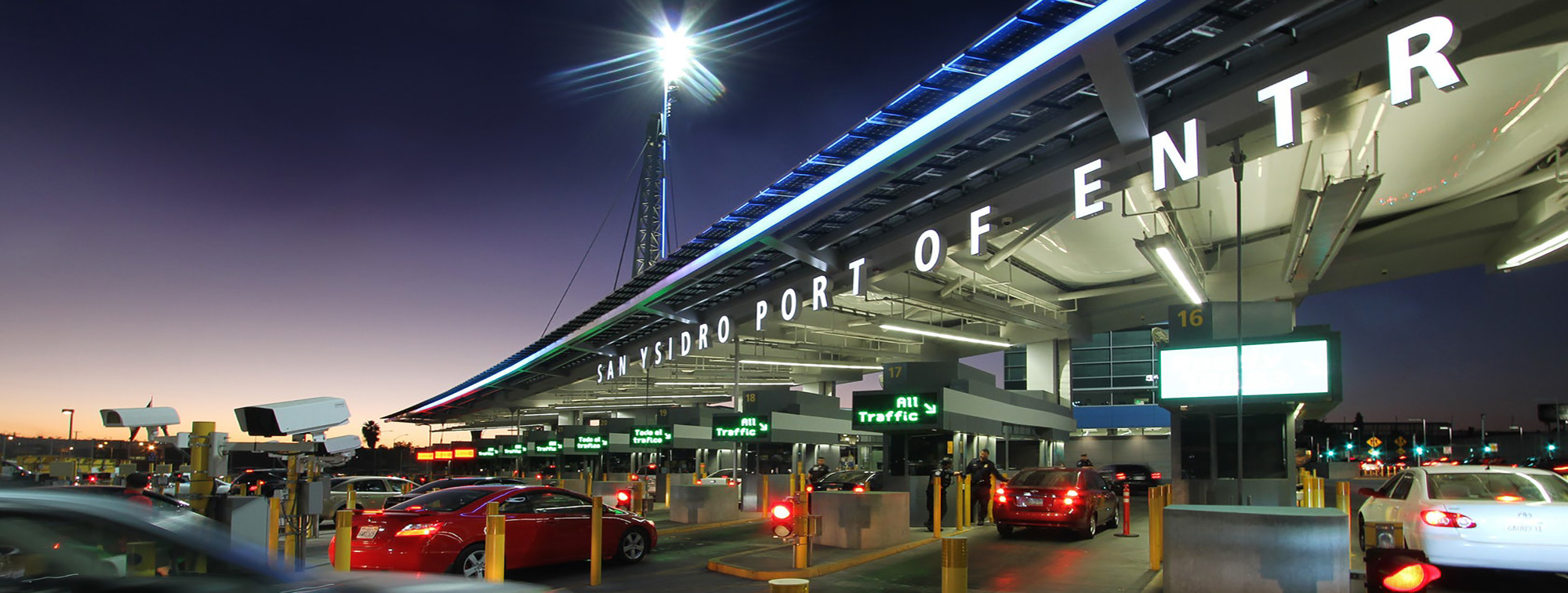San Ysidro Land Port of Entry
San Diego, California, U.S.A
The San Ysidro Point of Entry (POE) is the main border crossing between Mexico and the United States near San Diego, CA. The project consists of the final expansion of the primary and secondary canopies over the northbound and southbound routes through the POE. The Northbound Primary Canopy, designed by MKA Engineers, is a cantilevered, structural steel and cable structure supporting the approximately 20m wide x 45m long canopy section. There are a total of 19 cables connected to the roof. There are 13 cables from the top from which the structure hangs, and 6 cables beneath the structural steel frame working as hold-downs.
The EOR provided an erection sequence and the associated cable forces and displacements for the construction team to use to develop engineered erection plans, including a staged stressing sequence for the cables. Innova worked with the specialty fabricators and the erector to provide the following services:
1. Staged erection sequence to produce the cable forces.
2. Shoring and rigging specification, review, and in some cases, design.
3. On-site QA during the stressing sequence (not provided yet).
4. Peer Review of Pfeifer components.
Staged Sequence. Utilizing SAP 2000 Ultimate, Revit, and Tekla, Innova built a Finite Element Model (FEM) to represent the structure at the elevation and plan location of the finished structure, as indicated on the structural drawings. The general sequence was developed collaboratively with Pfeifer Worldwide, Beck Steel, and Pro Steel Erectors. To provide the deliverables, Innova worked to integrate the devices provided by Pfeifer, the fabrication limitations and schedule, and the preferences for the erector.
Using an iterative target force method, Innova developed a deformation controlled sequence to produce the required target cable forces within acceptable tolerances. The structure was evaluated for apparent overstresses during the sequence. Innova was responsible for resolving temporary overstresses during the stressing as well. The EOR validated the sequence by superimposing the sequence with their model. The final documents included a comprehensive QA plan for the cables. The final solution consist of a 29-step erection sequence.
Shoring and Rigging. Construction plans were developed by Innova. Shoring towers were delegated for design. Working with Pfeifer, six custom take-up devices were developed to stress the lower cables. Only three of the main support cables could be adjusted in the field, and that adjustment will be achieved using the manufacturer’s turnbuckle assemblies.
On-Site QA. While construction is delayed, Innova will provide Structural Observations during the erection operations. On-site observations are required to start at stage 13, which is the first stage where cable stressing operations will begin. The balance of the sequence provides instruction for the required documentation to be generated and submitted for Innova’s review. This QA is in addition to any QA/QC provided by the Owner.
Peer Review of Pfeifer components. The cables, spelter sockets, nodes, and associated hardware were developed by Pfeifer, in part, using the cable forces resulting from the staged sequence provided by Innova. Pfeifer retained Innova to perform a peer review of the node analysis they provided. In addition, Innova reviewed the cable analysis for compliance with the sequence and the project specifications.

